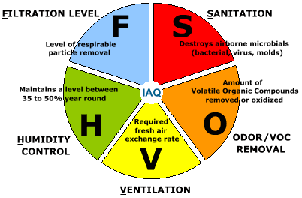Indoor Air Quality
 In the last several years, a growing body of scientific evidence has indicated that the air within homes and other buildings can be more seriously polluted than the outdoor air in even the largest and most industrialized cities. Other research indicates that people spend approximately 90 percent of their time indoors. Thus, for many people, the risks to health may be greater due to exposure to air pollution indoors than outdoors.
In the last several years, a growing body of scientific evidence has indicated that the air within homes and other buildings can be more seriously polluted than the outdoor air in even the largest and most industrialized cities. Other research indicates that people spend approximately 90 percent of their time indoors. Thus, for many people, the risks to health may be greater due to exposure to air pollution indoors than outdoors.
 Indoor air quality problems are not limited to homes. In fact, many office buildings have significant air pollution sources. Some of these buildings may be inadequately ventilated. For example, mechanical ventilation systems may not be designed or operated to provide adequate amounts of outdoor air. Finally, people generally have less control over the indoor environment in their offices than they do in their homes. As a result, there has been an increase in the incidence of reported health problems.
Indoor air quality problems are not limited to homes. In fact, many office buildings have significant air pollution sources. Some of these buildings may be inadequately ventilated. For example, mechanical ventilation systems may not be designed or operated to provide adequate amounts of outdoor air. Finally, people generally have less control over the indoor environment in their offices than they do in their homes. As a result, there has been an increase in the incidence of reported health problems.
Three major reasons for poor indoor air quality in office buildings are the presence of indoor air pollution sources; poorly designed, maintained, or operated ventilation systems; and uses of the building that were unanticipated or poorly planned for when the building was designed or renovated.
Providence College works diligently to prevent  poor indoor air quality by addressing those issues. The College attempts to detect and eliminate sources of indoor air pollutants; has implemented a preventative maintenance program for all HVAC systems; and attempts to use and occupy space for that which it was designed for.
poor indoor air quality by addressing those issues. The College attempts to detect and eliminate sources of indoor air pollutants; has implemented a preventative maintenance program for all HVAC systems; and attempts to use and occupy space for that which it was designed for.
If you are experiencing problems that you suspect may be caused by poor indoor air quality, contact the Office of Environmental, Health and Safety. For additional information on Indoor Air Quality, click on the link below.





